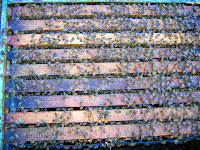I wanted to show my apprentice, Barbara, some beautiful queen cells in the Kingston yard. To my chagrin, the cells were small and the bees weren’t showing them the attention I normally see. I like to accentuate the positive so I put them back and continued my other tasks while Barbara gave me a running commentary, with fresh perspective, of a worker bee’ s first few minutes after emerging, which uplifted my spirit.
Later, I returned to the queen cells. Inside were queens that looked like they would be about the size of a worker! I expect to see left over royal jelly in a queen cell after her emergence and in these cells there was none. The explanation I think most likely is that there was too much open brood at the time the queens should have been getting fed. I have been placing the cell frames next to the youngest brood, and in this particular batch there was way more open brood than usual. In fact, there were a dozen brood frames in the two lower deep bodies and only four with pollen, nectar and honey.
Since there was so much open brood then, I think there is bound to be much less now. That aside, we decided to change tactics and delay the next graft for a couple days and give the bees some incentive to raise better queens. There is still a slight nectar flow going on, but tonight I installed an internal one gallon frame feeder.
Before: The top box has served as a convenient place to store food frames and where the bees have been drawing some foundation.
After: An escape board was placed underneath the super and a spacer box beneath that. Next down, an inner cover and then a super of foundation.
This picture shows many interesting features. Most obvious is the runny pollen supplement, in this case Bee-Pro from Mann Lake. I like to mix equal weights of Bee-Pro and water and combine that mixture with an equal amount of sugar (75g. Bee-Pro: 75g. water: 150g. sugar); next you can see the just filled feeder with 5:3 syrup. (If you use 5 lbs sugar, then 2:1 requires 2 ½ lbs of hot water. Ironically, if you mix this in a jar the level you achieve with just sugar is about the same after you add the water. I add another ½ lb of hot water so the sugar completely dissolves more easily with hot tap water). In the feeder is my latest generation float to prevent drowning. The holes let more bees feed at the same time. Lastly, you can see my color coded frame dots that tell when the frame’s foundation was added (same as queen colors).
Next day and ready for more!






No comments:
Post a Comment